The R1200GS makes BMW Motorrad’s world go around as GS owners go around the world or around the block.
According to Pieter de Waal, vice president of BMW Motorrad USA, the GS/GS Adventure account for almost 30% of BMW Motorrad’s volume of bikes sold worldwide.
With nearly one-third of bike sales coming from the big GS line, BMW needs to feed the beast regularly. That beast is the collective horde of GS and GS Adventure fanatics found in just about every corner of the planet.
With such a foundational role in BMW’s global success, the GS is always at the front of BMW’s mind. The company is endeavoring to keep the GS fresh, never willing to relinquish the lead position in what’s now known as the Adventure Touring category, a segment BMW unwittingly created in 1980 with its first Gelände/Straße motorcycle, the R80G/S.
Happy 30th!
Although this year’s updates to the GS aren’t specifically tied to its 30th year in production, BMW bestowed a racy update, so-to-speak, upon the GS’s Boxer-Twin.
New cylinder heads that borrow heavily from the HP2 Sport are the key upgrade for the 2010 GS.
The new heads sport dual overhead cams (the previous GS used a single cam-in-head design) along with a radial valve arrangement that includes larger intake and exhaust valves. Furthermore, the exhaust valves are sodium-filled to better control all the heat exhaust valves experience.
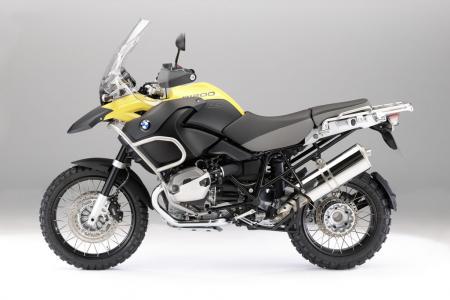 The 2010 GS Adventure takes GS-ing a few steps further with greater fuel capacity, a lower first gear, longer suspension travel and larger windscreen to name a few things. The 2010 GS Adventure takes GS-ing a few steps further with greater fuel capacity, a lower first gear, longer suspension travel and larger windscreen to name a few things. |
Other updates are new intake manifolds, larger throttle manifolds and new pistons to complement the updated and improved combustion chamber created by the new cylinder heads.
Additional improvements related to the Boxer-Twin include a new muffler with revised internals, and a new electronically controlled exhaust flapper valve that, according to BMW, helps the new GS currently meet upcoming Euro emissions standards for 2012.
The switch to the HP2 Sport’s cylinder heads and other updates listed above are good for 110 peak hp at 7750 rpm, an increase of 5 ponies, and a gain of 3 ft-lbs for 88 ft-lbs at 6000 rpm. Redline has also increased from 8000 to 8500 rpm.
But the slight power gain, says BMW, is only part of the story. More significant than the boost in peak power is a large improvement in low- and mid-range power the new flat-Twin provides.
From roughly 2500 to 5500 rpm the 2010 engine is said to open a sizeable gap in torque compared to the previous mill. According to a BMW-provided dyno chart, the gap appears largest in the 5000-rpm range, but prior to that point the new GS still makes considerably more torque.
The new bike’s power then trades places with the previous bike, dipping in the 5500 to 6000-rpm range where the other bike increased torque. However, the new model picks up again shortly thereafter, cleanly outpacing the old engine all the way to redline.
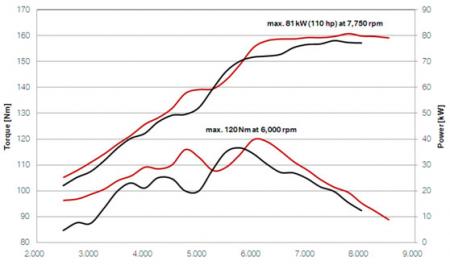 The red graph line represents the 2010 R1200GS. Note the big leap in torque right where it’s most needed on a bike like the GS: low- and mid-range. Max torque is 88 ft-lbs (120Nm). The red graph line represents the 2010 R1200GS. Note the big leap in torque right where it’s most needed on a bike like the GS: low- and mid-range. Max torque is 88 ft-lbs (120Nm). |
Lastly, subtle new graphics on the analog instrument gauges, an improved dial on the manually adjustable windscreen, and new clutch and brake master cylinders finish off the updates to the 2010 GS and GS Adventure.
Although the new GS looks virtually identical to the previous model, a keen eye will notice the new cylinder heads only employ two valve cover bolts whereas the 2008-09 generation has four bolts. If this doesn’t seem like a particularly splashy way to celebrate the globetrotting GS’s 30th birthday, fear not.
In the coming weeks BMW will unveil a special edition graphics package for all the GS models (F800 and R1200) in celebration of the GS heritage. Sorry, no sneak peeks from us.
| How the GS and GS Adventure differ | |||
| R1200GS | GS Adventure | Difference | |
| Fuel capacity (US gal) | 5.3 | 8.7 | 3.4 |
| Front suspension travel (inches) | 7.5 | 8.3 | 0.8 |
| Rear suspension travel (inches) | 7.9 | 8.7 | 0.8 |
| Seat Height (inches) | 33.5 | 35.0 | 1.5 |
| Dry weight (pounds) | 448 | 492 | 44 |
| 1st Gear Ratio | 2.38:1 | 2.60:1 | 9% reduction |
| Adventure’s Equipment | Protection bars | ||
| • Standard aluminum cylinder head covers | |||
| • Standard cross-spoke wheels | |||
| • Standard hand protection | |||
| • Larger windscreen | |||
A bike for all seasons
To get a taste of the most current version of the GS, BMW invited motopress from as far north as Canada and as far south as Mexico to the region surrounding California’s famous Yosemite National Park.
The rustic but comfortable Tenaya Lodge located in Fish Camp, Calif., with its arts and crafts movement-influenced styling, was our base of operations.
Highways 41, 49 and 140, along with a mix of paved two-lane roads and sometimes-rugged fire and mountain roads that occasionally demanded decent if not excellent dirt-riding skills, provided the circuitous route that carried us away from, into and then back out from Yosemite.
Road surfaces for the nearly 200-mile route were about 50/50 pavement and dirt.
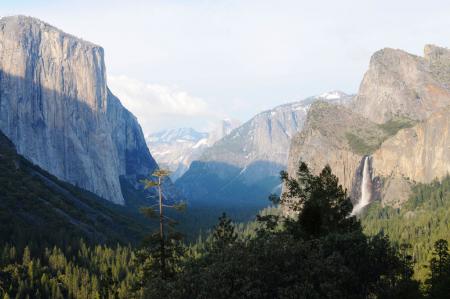 |
I was eager to see the natural splendor of renowned sites such as the sheer granite face of El Capitan, the cascading beauty of Bridalveil Falls and an awe-inspiring look at part of the Yosemite Valley as seen from Tunnel View. But the weatherman and Park Ranger “Smith” had other plans for what would be my second opportunity in about six years to travel the Park on two wheels. Foiled again!
A late season (or early season depending on how you see it) storm slammed the region during the ride. We experienced everything from partly cloudy skies and mild temps to driving rain, sleet, hail and eventually a snowy whiteout as we entered the park.
The GS issued an ominous warning as 36 F and a snowflake icon flashed across the LCD, as if to overstate the obvious hazards of riding while the temperature was so low.
Truth is, we often saw 32 F as we ascended to over 7000 feet, but as noted the Beemer’s gauge starts alerting its rider well in advance of the freezing point.
Foggy, snowy conditions obscured from view almost all the magnificent sights we came to see, leaving many of us with that one-day-late-and-a-dollar-short feeling. Only 24 to 48 hours prior, temps were summerlike, according to locals.
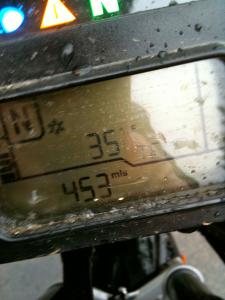 Furthermore, before we could reach our pivot point near Yosemite Village, where Northside Dr. becomes Southside Dr. (the entire route is Hwy 140), to descend back down and then out of the park via Hwy. 41, a hapless motorist, or three, lacked the skill set necessary to navigate through several inches of slushy snow.
Furthermore, before we could reach our pivot point near Yosemite Village, where Northside Dr. becomes Southside Dr. (the entire route is Hwy 140), to descend back down and then out of the park via Hwy. 41, a hapless motorist, or three, lacked the skill set necessary to navigate through several inches of slushy snow.Apparently said car driver(s) careened off the edge, crashed or simply got sideways – the story changed a little each time – and caused enough roadway mayhem that a long line of stopped cars formed. Unfortunately, a park ranger sent us BMW GS riders back from whence we came. Cars were allowed though, but for whatever reason, the ranger was unreasonable toward the bikes.
Clearly the ranger failed to recognize the GS’s potential to surmount just about any riding circumstance set before it.
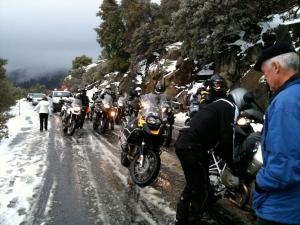 Had many of us not been soaked and frozen to one degree or another we might’ve attempted to more convincingly petition the ranger to let us pass. Instead, with hearts full of icy resentment, we ambled back the way we came; subsequently increasing the length of the trip back to the Tenaya by at least double the distance than if we’d been allowed to continue on the original route.
Had many of us not been soaked and frozen to one degree or another we might’ve attempted to more convincingly petition the ranger to let us pass. Instead, with hearts full of icy resentment, we ambled back the way we came; subsequently increasing the length of the trip back to the Tenaya by at least double the distance than if we’d been allowed to continue on the original route.As something of a final salting to our wounded egos, my ride group was frozen in its tracks, as we had to call it quits in the town of Oakhurst, only 10 miles or so from Tenaya Lodge. The California Highway Patrol closed the road to Tenaya due to heavy snowfall.
Adding insult to injury, we later learned that the first group of GS-riding journos to come upon the cluster of cars atop the summit had outsmarted or outmaneuvered the overzealous ranger and continued on with the original route. The rules-be-damned gang arrived at the lodge with fewer miles on the clock and at least a couple hours in advance of the rest of the fractured parties. They become known as The Magnificent Seven.
“That’s a so-so entertaining tale, Pete. But what about the dern bike?!”
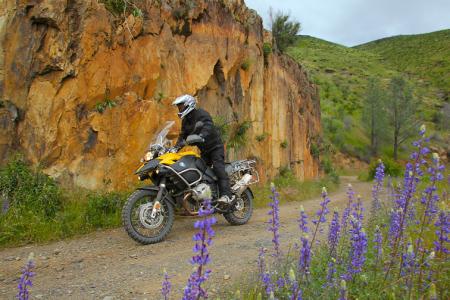 The GS Adventure in its element. This mildly challenging gravel mountain road is a cakewalk for globetrotting Adventure. The GS Adventure in its element. This mildly challenging gravel mountain road is a cakewalk for globetrotting Adventure. |
Glad you asked.
An all-new, high-performance cylinder head is significant news for the 2010 R1200GS and GS Adventure. However, if you’re paying attention, you’ll recall that was the crux of what’s new on the GS.
Unless you had either the chance to run an ’09 against a ’10 on the dyno, or ride them back to back, you’d be hard-pressed to get a true sense of the new grunt BMW says the latest GS possesses in contrast to the previous model.
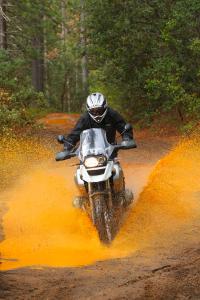 As fate would have it, a smattering of ‘09s was around, but with 40 some riders vying for them, not to mention everyone racing to beat the weather, regrettably I wasn’t able to saddle last year’s model.
As fate would have it, a smattering of ‘09s was around, but with 40 some riders vying for them, not to mention everyone racing to beat the weather, regrettably I wasn’t able to saddle last year’s model.The good news is the GS is still very much what the previous bike was, and that’s, well, good.
When I last rode a GS it was Spring 2008, so my reference point to previous engine performance was limited. Conducting something of an unscientific test of this new low- and mid-range power I short-shifted to 6th gear and let the revs fall.
The big Boxer pulled top gear from as low as approximately 2000 rpm. It didn’t necessarily do so effortlessly, but neither did it shudder, sputter and protest like an engine being lugged. Rather, it pulled the big gear at low revs with a tractor-like resolve.
Torque is plentiful with gearing ratios to match. Shifting seemed optional at times: twist ‘n’ go.
Polling a couple of fellow riders got mixed reactions about the new mill. One was certain he could feel the increase in power BMW says is there, while still another rider who owns a 2008 GS said he found nothing perceptibly different from the new engine’s performance over what the pervious model offered.
Sussing out whether the newly increased power is there to the degree BMW says it is may prove tough unless a dyed-in-the-wool GS fanatic out there wants to pony up with a 2008/09 GS so Motorcycle.com can dyno and/or ride it against a 2010. Any takers?
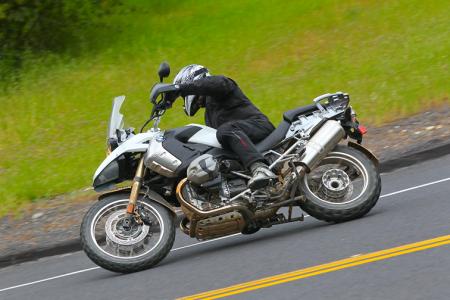 The GS is just as capable of gobbling up paved miles as it is the dirt. Although the off-road-biased Metzeler Karoo tires spooned on the GS for this trip don’t perform as well on-road as a street-only tire will, they nevertheless provide a surprising amount of feedback for a dirt tire on pavement. And, of course, they excelled on gravel roads and the trail. The GS is just as capable of gobbling up paved miles as it is the dirt. Although the off-road-biased Metzeler Karoo tires spooned on the GS for this trip don’t perform as well on-road as a street-only tire will, they nevertheless provide a surprising amount of feedback for a dirt tire on pavement. And, of course, they excelled on gravel roads and the trail. |
Everything else about my experience aboard the 2010 GS served as a reminder of the various things I enjoyed about the previous model: an easily modulated clutch with light lever action joined by an equally light-shifting and precise six-speed gearbox; powerful front brakes with the benefit of BMW’s refined and unobtrusive ABS; excellent fueling and throttle response; and its good handling traits on- and off-road, especially for a hefty (504 lbs curb weight GS; 564 lbs curb weight GSA) bike that purports to do it all.
I was also reminded that the bikes’ windscreens do a fair job of protecting the rider considering the screens' size and shape, but they also produce noticeable buffeting when ridden at quicker paces more typical for paved roads.
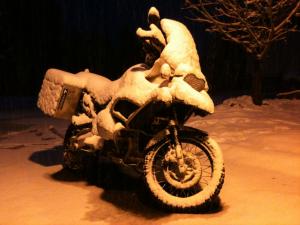 The Adventure’s 35.8-inch seat height and extra weight carried high due to its additional 3.4 gallons of fuel can present a genuine challenge to paddling around a parking lot or looking for a secure place to plant a boot when off-road, especially if you stand less than, say, six feet tall.
The Adventure’s 35.8-inch seat height and extra weight carried high due to its additional 3.4 gallons of fuel can present a genuine challenge to paddling around a parking lot or looking for a secure place to plant a boot when off-road, especially if you stand less than, say, six feet tall.Another gem I appreciate is BMW’s electronically controlled suspension adjustment system. Tailored for the GS line, it’s called Enduro ESA rather than just ESA that’s available for BMW’s streetbikes.
Enduro ESA adds six rider-selectable settings specifically for off-road environs. These additional settings join nine on-road settings to create a grand total of 15 separate suspension settings. Enduro ESA is an electronic treat of the highest order and only adds $800 to the bottom line when purchased as an a la carte option.
As matter of opinion, many of the options on offer – like heated grips when it’s 32 F outside! – seem well worth the extra coin.
| 2010 R1200GS Options Packages | R1200GS | R1200GS Adventure |
| Standard Package | $16,400 | $18,700 |
| Heated grips | Heated grips | |
| Hand protection | Integral ABS | |
| Integral ABS | Saddle bag mounts | |
| Premium Package | $17,695 | $20,245 |
| Std. Package Plus: | Std. Package Plus: | |
| Enduro ESA | Enduro ESA | |
| On-board Computer | On-board Computer | |
| Saddle bag mounts | Fog light | |
| Destination Charge (not included in MSRP) | $495 | $495 |
This year the R1200GS brings a base MSRP of $14,950, while the Adventure rings in with a starting price tag of $17,000.
And like many of their road-only kin, the GS and Adventure have turnkey options packages that BMW says include a number of the items customers gravitate toward. In addition to the goodies included in the above packages, other factory-installed extras are available; all options can be purchased separately.
The GS has remained in BMW’s lineup for 30 years. With roomy ergos, a torquey but manageable Boxer Twin, and loads of electronics that benefit the rider now available, it’s not much of a stretch to imagine the GS will probably celebrate its 60th Anniversary, too.



 9:07 AM
9:07 AM
 Unknown
Unknown


 Posted in:
Posted in: 




0 comments:
Post a Comment